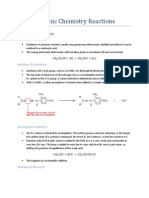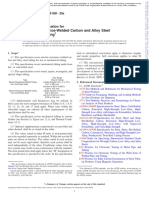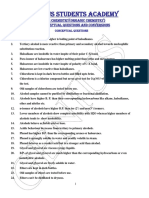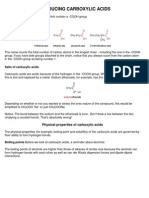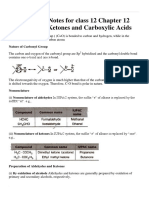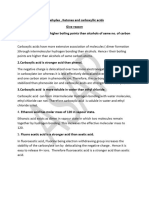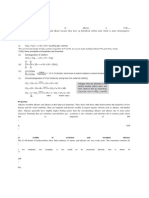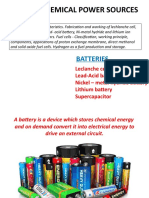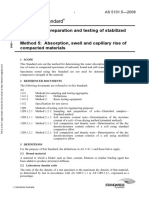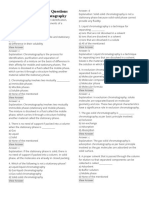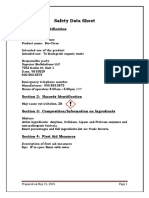Exp 4 Dipad
Exp 4 Dipad
Uploaded by
Grace HipolitoCopyright:
Available Formats
Exp 4 Dipad
Exp 4 Dipad
Uploaded by
Grace HipolitoOriginal Title
Copyright
Available Formats
Share this document
Did you find this document useful?
Is this content inappropriate?
Copyright:
Available Formats
Exp 4 Dipad
Exp 4 Dipad
Uploaded by
Grace HipolitoCopyright:
Available Formats
1.
Explain why sodium bicarbonate solution is most useful in determining the presence of a carboxylic
acid.
They interact with sodium bicarbonate because carboxylic acids prefer to give protons and are more
reactive than carbonic acids. The following kind of carbonic acid will be unstable and instantly release
water and carbon dioxide. Since it easily combines with acidic solutions to produce carbon dioxide,
which is then quickly expelled from the solution with the creation of sodium acetate, sodium
bicarbonate is the most effective substance for detecting the presence of a carboxylic acid.
2. Identify a test that will distinguish between the compounds of each of the following pairs:
a. Pentanoic acid and pentanal
b. Pentanoic acid and ethyl propanoate
c. Ethyl propanoate and N-ethylpropanamide
d. N-ethylpropanamide and N,N-dimethylpropanamide
e. Ethyl propanoate and propanoyl chloride
3. Arrange the following types in order of increasing acidity: carboxylic acids, alcohols, phenols, water.
Explain why.
Alcohols < water < phenols < carboxylic acids
The stability of the conjugate base created by the proton donation determines the acidity of a
compound. With increasing acidity of the compound, the stability of the conjugate base will also rise,
and back.
Carboxylic acids are more acidic than alcohols, water, and phenols because the carboxylate ion, the
conjugate acid of carboxylic acids, is stabilized by resonance. This type of resonance structure cannot be
displayed by the alkoxide ion, which is the conjugate base of alcohol, or the phenoxide ion (the
conjugate base of phenol).
Phenols are more acidic than carboxylic acids
because the benzene ring stabilizes the phenoxide ion. Oxygen will draw electrons and produce a
negative charge since it is an electronegative atom. It also takes part in delocalization since it has a lone
pair of electrons. Alcohols are also generally weaker acids than water. Alcohol's OH groups are less polar
than those of water, which explains why this is the case. The capacity of the R group to release electrons
causes alcohol to lose its acidity by lowering the polarity of the OH bond. As a result, water is a better
proton donor than alcohol.
Alcohol absorbs a proton and releases alcohol in exchange, but water is a superior proton source. Due to
the oxygen atom's formation by the active groups linked to alcohol, alcohol is less acidic than water.
Stronger. Phenols are more acidic than both water and alcohol due to the stability of its conjugate base
and the absence of the analogous water base, -OH. As a result of the strengthening effect of the
conjugate base of carboxylic acids, Carboxylic acids have two equal resonance fractions, which efficiently
reveal the negative charge among other electronegative oxygen atoms.
4. Arrange the following types in order of decreasing ease of hydrolysis: acid halides, acid anhydrides,
esters and amides. Give the theoretical explanation for the observed differences in reactivity.
acid halides > acid anhydrides > esters > amides
Different derivatives of carboxylic acids will react in a wide range of ways. The most and least reactive
substances during hydrolysis, respectively, are acyl chlorides and bromides. The level of reaction has
significantly altered.
A fast reaction between acyl chlorides and water occurs in homogeneous solvent systems without the
need of heat or catalysts. On the other hand, amides only interact with water when strong acid or base
catalysts and external heating are present.
5. Write a complete reaction of succinic acid and acetic anhydride.
6. Write equations that describe the reaction mechanism for acid hydrolysis of each of the following
compounds: a) acetyl chloride and b) acetic anhydride.
a.) acetyl chloride
final hydrogen ion elimination by Cl- to produce ethanoic acid and HCl
b.) acetic anhydride
You might also like
- Amy Benson 5042456 Con108 As3Document19 pagesAmy Benson 5042456 Con108 As3Keira & BraxNo ratings yet
- Unit 4 Organic Chemistry ReactionsDocument6 pagesUnit 4 Organic Chemistry ReactionsRobbing_Hood100% (1)
- A Narrative ReportDocument6 pagesA Narrative ReportGrace Hipolito69% (13)
- Brochure - Edilonsedra SDS M Sound Damping System Modular - ENDocument16 pagesBrochure - Edilonsedra SDS M Sound Damping System Modular - ENAlejandro Escoto GarcíaNo ratings yet
- Electric-Resistance-Welded Carbon and Alloy Steel Mechanical TubingDocument21 pagesElectric-Resistance-Welded Carbon and Alloy Steel Mechanical TubingIsaac ZTNo ratings yet
- UntitledDocument15 pagesUntitlednatNo ratings yet
- Alcohols, Carboxylic Acids and EstersDocument47 pagesAlcohols, Carboxylic Acids and Estersrheanna0076No ratings yet
- Acid Base PropertiesDocument5 pagesAcid Base PropertiesWNo ratings yet
- Carboxylic Acid - NotesDocument16 pagesCarboxylic Acid - NotesVANSHIKA GOELNo ratings yet
- Carboyxlic Acids and DerivativesDocument4 pagesCarboyxlic Acids and DerivativesNurain 4185No ratings yet
- Organic DerivativesDocument24 pagesOrganic Derivativesami tiu100% (1)
- Carboxylic Acids ..Document27 pagesCarboxylic Acids ..Mariam HamedNo ratings yet
- Ch-11 Part-2 Alcohols, Phenols ðersDocument57 pagesCh-11 Part-2 Alcohols, Phenols ðersBhavishya VermaNo ratings yet
- Acids&Acid DerivativesDocument5 pagesAcids&Acid DerivativesStephanie Joy EscalaNo ratings yet
- CHAPTER 5 Carboxyl CHM413Document40 pagesCHAPTER 5 Carboxyl CHM413Anis NasuhaNo ratings yet
- Conceptual Questions_ChemistryDocument20 pagesConceptual Questions_Chemistryadityasharmaad1904No ratings yet
- Experiment 9 Laboratory ReportDocument9 pagesExperiment 9 Laboratory ReportjuneNo ratings yet
- Aldehydes, Ketones and Carboxylic Acids Question Bank (Subjective)Document16 pagesAldehydes, Ketones and Carboxylic Acids Question Bank (Subjective)helixvector45411No ratings yet
- Acidic Strength NCERT TheoryDocument6 pagesAcidic Strength NCERT Theorystudydude020No ratings yet
- Chapter FiveDocument32 pagesChapter FiveDav SugoNo ratings yet
- Organic Chemistry (Conceptual Questions)Document31 pagesOrganic Chemistry (Conceptual Questions)Vanshika MauryaNo ratings yet
- CH 117 Notes 3Document6 pagesCH 117 Notes 3Benson ShayoNo ratings yet
- Acid Derivatives: Nucleophilic Substitution: Alkyl vs. AcylDocument10 pagesAcid Derivatives: Nucleophilic Substitution: Alkyl vs. AcylKarthik SharmaNo ratings yet
- Acid Derivatives: Nucleophilic Substitution: Alkyl vs. AcylDocument10 pagesAcid Derivatives: Nucleophilic Substitution: Alkyl vs. AcylKarthik SharmaNo ratings yet
- Alcohols, Ethers and Phenols - 3Document65 pagesAlcohols, Ethers and Phenols - 3karansmaraviNo ratings yet
- Phenol: A Guide For CAPE StudentsDocument11 pagesPhenol: A Guide For CAPE StudentsJordan SteeleNo ratings yet
- Alcohols, Phenols and Ethers 2Document167 pagesAlcohols, Phenols and Ethers 2Omkar Singh ShekhawatNo ratings yet
- Alcohols, Phenols and Ethers - WatermarkDocument44 pagesAlcohols, Phenols and Ethers - Watermarkasp212009No ratings yet
- Introducing Carboxylic AcidsDocument24 pagesIntroducing Carboxylic AcidsRohini SelvarajahNo ratings yet
- Chemistry Notes For Class 12 Chapter 12 Aldehydes, Ketones and Carboxylic AcidsDocument26 pagesChemistry Notes For Class 12 Chapter 12 Aldehydes, Ketones and Carboxylic AcidsDipankar YadavNo ratings yet
- Carboxylic Acids - 2023Document15 pagesCarboxylic Acids - 2023Sangay ChodenNo ratings yet
- Alcohols: N n+1 N 2n+2Document18 pagesAlcohols: N n+1 N 2n+2PrakharNo ratings yet
- Alcohols, Phenols & Ethers - Points To RememberDocument3 pagesAlcohols, Phenols & Ethers - Points To RememberNeira DSouzaNo ratings yet
- Expt 5 Carboxylic Acids and EstersDocument5 pagesExpt 5 Carboxylic Acids and EstersmendozakaceeyNo ratings yet
- Discussion Exp 1 CHM 301 Alcohol TestDocument4 pagesDiscussion Exp 1 CHM 301 Alcohol TestCik Mira YusoffNo ratings yet
- Chapter 3 - Carboxylic Acid 2024Document59 pagesChapter 3 - Carboxylic Acid 2024isfaNo ratings yet
- Solubility Tests On Organic CompoundsDocument6 pagesSolubility Tests On Organic CompoundsVanessaOlgaJ.Dagondon0% (2)
- Aldehydes Ketone Carboxylic AcidsDocument4 pagesAldehydes Ketone Carboxylic AcidspoornaNo ratings yet
- 2 - Solubility of Organic CompoundsDocument4 pages2 - Solubility of Organic CompoundsJade AsparinNo ratings yet
- Science Fair Project: Type Your Project Title Here Your Name Your Teacher's Name Your SchoolDocument290 pagesScience Fair Project: Type Your Project Title Here Your Name Your Teacher's Name Your SchoolmanueveredNo ratings yet
- Alcohols 2Document15 pagesAlcohols 2Mugisha IvanNo ratings yet
- alocoholphenolandethers1725364328 (1)Document89 pagesalocoholphenolandethers1725364328 (1)F ZNo ratings yet
- Chem 9Document4 pagesChem 9Emmanuel PlazaNo ratings yet
- Revision Booket-4 (Organic Chemistry) (18 Marks) : A Complete Revision Material For Class XII As Per New Syllabus of NCERTDocument14 pagesRevision Booket-4 (Organic Chemistry) (18 Marks) : A Complete Revision Material For Class XII As Per New Syllabus of NCERTabiNo ratings yet
- Alcohols, Phenols and Ethers - Notes (1)Document11 pagesAlcohols, Phenols and Ethers - Notes (1)Aditya RiseNo ratings yet
- Carboxylic AcidDocument9 pagesCarboxylic AcidjohnsmithprayNo ratings yet
- 2) Unit-IIDocument16 pages2) Unit-IIjunjag79No ratings yet
- Aldehydes and Ketones .NotesDocument32 pagesAldehydes and Ketones .NotesvishalNo ratings yet
- Lesson 14 Acidic and Basic Character of Organic CompoundsDocument35 pagesLesson 14 Acidic and Basic Character of Organic Compoundsdela2No ratings yet
- Rings, Polymers and Analysis (Unit 4) - OCR Chemistry Notes - Robbie PeckDocument14 pagesRings, Polymers and Analysis (Unit 4) - OCR Chemistry Notes - Robbie Peckrobbiepeck100% (1)
- Carboxylic Acids and Their DerivativesDocument5 pagesCarboxylic Acids and Their DerivativesCrissalyn AyentoNo ratings yet
- Laporan IGF AlimDocument11 pagesLaporan IGF Alimppg.risdaniar99130No ratings yet
- Give reason Aldehydes Ketones and carboxylic acids 2024-25Document5 pagesGive reason Aldehydes Ketones and carboxylic acids 2024-25archit.lakhani20No ratings yet
- L4 - Acids, Esters and Its DerivativesDocument48 pagesL4 - Acids, Esters and Its DerivativesAlexNo ratings yet
- Exp 9 Alcohols and PhenolsDocument21 pagesExp 9 Alcohols and Phenolsmajdkhashan999No ratings yet
- Exp 2 NdlastDocument2 pagesExp 2 NdlastShanayaNjNo ratings yet
- Chemistry_questionsDocument7 pagesChemistry_questionscreator.krutiNo ratings yet
- Member SinceDocument2 pagesMember Sincethe punisher 1No ratings yet
- Acidic and Basic Character of Organic CompoundsDocument35 pagesAcidic and Basic Character of Organic CompoundsLoveena Steadman100% (1)
- Functional Groups: Naming of EstersDocument6 pagesFunctional Groups: Naming of EsterspappadakunduNo ratings yet
- Al KynesDocument16 pagesAl KynesShivam GuptaNo ratings yet
- A. Experiment Title: The Making of N-Butyl Acetate B. Experiment Started Date: Wednesday, March 4Document21 pagesA. Experiment Title: The Making of N-Butyl Acetate B. Experiment Started Date: Wednesday, March 4Era MelaniaNo ratings yet
- Practice Makes Perfect in Chemistry: Acids, Bases, and Salts with AnswersFrom EverandPractice Makes Perfect in Chemistry: Acids, Bases, and Salts with AnswersNo ratings yet
- Demand Letter - HipolitoDocument1 pageDemand Letter - HipolitoGrace HipolitoNo ratings yet
- Exp 6 PLQ 1-3Document1 pageExp 6 PLQ 1-3Grace HipolitoNo ratings yet
- Exp 2 DipadDocument5 pagesExp 2 DipadGrace HipolitoNo ratings yet
- Preliminary Data Sheet - Experiment 3 - Group4Document5 pagesPreliminary Data Sheet - Experiment 3 - Group4Grace HipolitoNo ratings yet
- Allay ZaDocument4 pagesAllay ZaGrace HipolitoNo ratings yet
- Allay ZaDocument4 pagesAllay ZaGrace HipolitoNo ratings yet
- Examples of Using Direct Quotes, Paraphrasing, and SummarizingDocument3 pagesExamples of Using Direct Quotes, Paraphrasing, and SummarizingGrace HipolitoNo ratings yet
- Ii. Time, Continuity, and ChangeDocument2 pagesIi. Time, Continuity, and ChangeGrace HipolitoNo ratings yet
- Electromagnetic Wave.: Light Is AnDocument9 pagesElectromagnetic Wave.: Light Is AnGrace HipolitoNo ratings yet
- Electrochemical Power Sources: BatteriesDocument31 pagesElectrochemical Power Sources: BatteriessudhaNo ratings yet
- False Ceiling: Done and Submitted By: Bushra Khan and Siddhartha VermaDocument17 pagesFalse Ceiling: Done and Submitted By: Bushra Khan and Siddhartha VermaAshuthosh MurulyaNo ratings yet
- Course Handout (BMP)Document4 pagesCourse Handout (BMP)058-Somyajit RayNo ratings yet
- Pollution Prevention Control in Dairy IndustryDocument7 pagesPollution Prevention Control in Dairy Industryyusuf anwerNo ratings yet
- Reference Guide To Wide Bandgap SemiconductorsDocument1 pageReference Guide To Wide Bandgap SemiconductorsKiril KolesnikovNo ratings yet
- Casar Katalog 2013Document43 pagesCasar Katalog 2013sinojNo ratings yet
- EN8 Steel: BS970: 1955 EN8, BS970/PD970: 1970 OnwardsDocument1 pageEN8 Steel: BS970: 1955 EN8, BS970/PD970: 1970 Onwardsgowtham_venkat_4No ratings yet
- Conductivity Cell Care and Maintenance Procedures: Technical TipDocument2 pagesConductivity Cell Care and Maintenance Procedures: Technical TipMuhammad AdreesNo ratings yet
- Jaime1997 - Hall-Effect Sign Anomaly and Small-Polaron Conduction in sLa12xGdxd0.67Ca0.33MnO3Document4 pagesJaime1997 - Hall-Effect Sign Anomaly and Small-Polaron Conduction in sLa12xGdxd0.67Ca0.33MnO3Partha sarathi padhiNo ratings yet
- Btc3302 - Practical 1Document11 pagesBtc3302 - Practical 1Annisha Izzatie100% (1)
- FCP 1100BDocument3 pagesFCP 1100BSalviano EvaristoNo ratings yet
- As 5101.5-2008 Methods For Preparation and Testing of Stabilized Materials Absorption Swell and Capillary RisDocument2 pagesAs 5101.5-2008 Methods For Preparation and Testing of Stabilized Materials Absorption Swell and Capillary RisSAI Global - APACNo ratings yet
- Material Balance (A) : 3.1 AssumptionsDocument11 pagesMaterial Balance (A) : 3.1 Assumptionssaur1No ratings yet
- Engineering Chemistry Questions and AnswersDocument24 pagesEngineering Chemistry Questions and AnswersFrancine Dawn MoloNo ratings yet
- Safety Data Sheet: Section 1: IdentificationDocument4 pagesSafety Data Sheet: Section 1: IdentificationHka IsmailNo ratings yet
- Válvulas Solenoides ASCO 3 Vias ECIDocument31 pagesVálvulas Solenoides ASCO 3 Vias ECIJuan Carlos Pardo RimachiNo ratings yet
- HattarDocument6 pagesHattartahaNo ratings yet
- Firetec Bs 7846 LPCB Basec Approved Power CableDocument5 pagesFiretec Bs 7846 LPCB Basec Approved Power CableSanjay MNo ratings yet
- Breakout Soft Seating Prices - SpaceistDocument23 pagesBreakout Soft Seating Prices - SpaceistChris DaviesNo ratings yet
- Rez CoatDocument10 pagesRez CoatRowelito TalawanNo ratings yet
- Program of WorkDocument62 pagesProgram of WorkJimmy PimentelNo ratings yet
- ASSAB PM 23 SuperClean Brochure English PDFDocument12 pagesASSAB PM 23 SuperClean Brochure English PDFnithiNo ratings yet
- Ceramic Coatings For High-Temperature Protection of Steel: by N. GDocument15 pagesCeramic Coatings For High-Temperature Protection of Steel: by N. GCatalin SfatNo ratings yet
- Structural Assignment 2Document21 pagesStructural Assignment 2Praveen FernandoNo ratings yet
- Atoms Elements and CompoundsDocument3 pagesAtoms Elements and CompoundsIfenna Ikenna-Okeke100% (1)
- Owner'S General Engine: Manual GasolineDocument72 pagesOwner'S General Engine: Manual GasolineFrançois CantinNo ratings yet
- Validation of Empirical Formulas To Derive Model Parameters For SandsDocument6 pagesValidation of Empirical Formulas To Derive Model Parameters For SandsObaid Ur RehmanNo ratings yet

